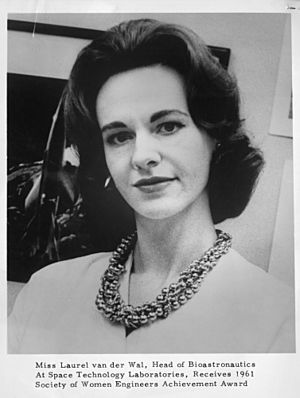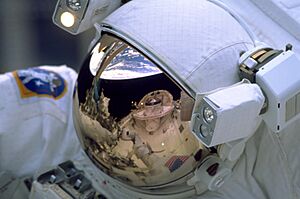Bioastronautics facts for kids

Bioastronautics is a science that studies how living things, especially humans, survive and thrive in outer space. It combines ideas from biology (the study of life) and astronautics (the science of space travel). This field looks at how space affects our bodies and minds. It also helps design space vehicles, space habitats, and life-support systems. In short, bioastronautics is all about supporting life in space.
This science is similar to astronautical hygiene. Both study the dangers humans might face during space flights. Astronautical hygiene focuses on finding these dangers, figuring out the risks, and then creating ways to protect astronauts. This includes understanding things like Moon dust and how to keep astronauts safe from it.
Contents
What is Bioastronautics?
Bioastronautics explores many interesting questions. For example, how does the lack of strong gravity in space affect living things? This low gravity is often called "microgravity".
Life in Microgravity
In microgravity, things float instead of settling down. This changes how cells and fluids behave inside living organisms. On Earth, gravity guides how plants grow. For instance, plant roots grow down, and stems grow up. In space, without this pull, plants might grow differently.
Also, living things in space don't need to use energy to fight gravity. This extra energy can be used for other things. Some worms, like C. elegans, and tiny wasps, like Spangia endius, might grow faster in space. Even plants, such as the rosy periwinkle (Catharanthus roseus), can produce more helpful chemicals in space. These chemicals, like vincristine, are used in medicine.
Engineering for Space Life
Engineers in bioastronautics face big challenges. They need to figure out how to provide air, food, and water for astronauts. They also design ways to handle waste products.
Closed Life Support Systems
A major goal is to create systems that can recycle everything. These are called Closed Ecological Life Support Systems (CELSS). They work like a tiny, self-sustaining ecosystem. Imagine a mini-Earth inside a spaceship! These systems are key for long trips, like a mission to Mars.
Medical Challenges in Space
Long space missions can affect astronauts' bodies. Bioastronautics also studies these medical concerns.
Bone and Kidney Health
One issue is that bones can lose calcium quickly, similar to conditions like osteoporosis on Earth. Another serious concern is how space travel affects the kidneys. Scientists are studying this closely. If astronauts spend about three years in space, like on a Mars mission, they might need special medical help when they return. This research helps keep astronauts healthy. It also helps doctors on Earth find new ways to treat similar health problems.
See also
- Effect of spaceflight on the human body
- Life support system
- Space habitation
- Locomotion in space
- Reduced muscle mass, strength and performance in space
- Space food
- Astronautical hygiene
- Spaceflight radiation carcinogenesis
- Space medicine
- Space tourism
- Space-based economy
- List of spaceflight-related accidents and incidents
- Writing in space
- Space art#Art in space
- Religion in space
- Organisms at high altitude
- Astrobiology
- Astrobotany
- Plants in space


